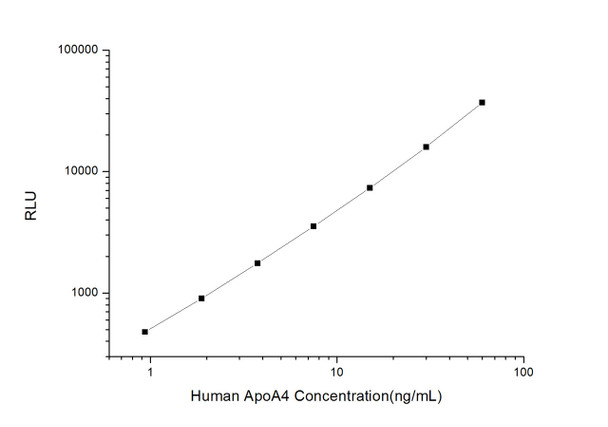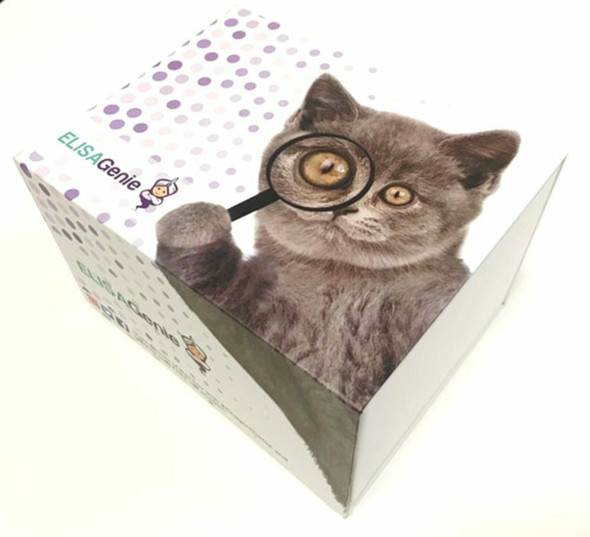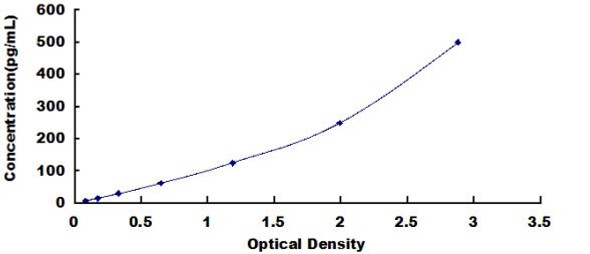Human Cell Biology ELISA Kits 3
Human ApoA4 (Apolipoprotein A4) CLIA Kit (HUES00330)
- SKU:
- HUES00330
- Product Type:
- ELISA Kit
- ELISA Type:
- CLIA Kit
- Size:
- 96 Assays
- Sensitivity:
- 0.56ng/mL
- Range:
- 0.94-60ng/mL
- ELISA Type:
- Sandwich
- Synonyms:
- APOA4,Apolipoprotein A-IV , ApoA-IV,ApoAIV,apoA4,
- Reactivity:
- Human
- Sample Type:
- Serum, plasma and other biological fluids
- Research Area:
- Cell Biology
Description
| Assay type: | Sandwich |
| Format: | 96T |
| Assay time: | 4.5h |
| Reactivity: | Human |
| Detection method: | Chemiluminescence |
| Detection range: | 0.94-60 ng/mL |
| Sensitivity: | 0.56 ng/mL |
| Sample volume: | 100µL |
| Sample type: | Serum, plasma and other biological fluids |
| Repeatability: | CV < 15% |
| Specificity: | This kit recognizes Human ApoA4 in samples. No significant cross-reactivity or interference between Human ApoA4 and analogues was observed. |
This kit uses Sandwich-CLIA as the method. The micro CLIA plate provided in this kit has been pre-coated with an antibody specific to Human ApoA4. Standards or samples are added to the appropriate micro CLIA plate wells and combined with the specific antibody. Then a biotinylated detection antibody specific for Human ApoA4 and Avidin-Horseradish Peroxidase (HRP) conjugate are added to each micro plate well successively and incubated. Free components are washed away. The substrate solution is added to each well. Only those wells that contain Human ApoA4, biotinylated detection antibody and Avidin-HRP conjugate will appear fluorescence. The Relative light unit (RLU) value is measured spectrophotometrically by the Chemiluminescence immunoassay analyzer. The RLU value is positively associated with the concentration of Human ApoA4. The concentration of Human ApoA4 in the samples can be calculated by comparing the RLU of the samples to the standard curve.
| UniProt Protein Function: | APOA4: May have a role in chylomicrons and VLDL secretion and catabolism. Required for efficient activation of lipoprotein lipase by ApoC-II; potent activator of LCAT. Apoa-IV is a major component of HDL and chylomicrons. Synthesized primarily in the intestine and secreted in plasma. Belongs to the apolipoprotein A1/A4/E family. |
| UniProt Protein Details: | Protein type:Cell adhesion; Endoplasmic reticulum; Lipid-binding; Secreted; Secreted, signal peptide Chromosomal Location of Human Ortholog: 11q23. 3 Cellular Component: cell surface; chylomicron; cytosol; early endosome; endoplasmic reticulum lumen; extracellular matrix; extracellular region; extracellular space Molecular Function:antioxidant activity; cholesterol binding; cholesterol transporter activity; copper ion binding; lipid binding; lipid transporter activity; phosphatidylcholine binding; protein binding; protein homodimerization activity Biological Process: cellular protein metabolic process; cholesterol biosynthetic process; cholesterol efflux; cholesterol homeostasis; cholesterol metabolic process; hydrogen peroxide catabolic process; innate immune response in mucosa; leukocyte adhesion; lipid homeostasis; lipid transport; lipoprotein metabolic process; multicellular organismal lipid catabolic process; neuron projection regeneration; phosphatidylcholine metabolic process; phospholipid efflux; positive regulation of fatty acid biosynthetic process; positive regulation of lipoprotein lipase activity; protein-lipid complex assembly; regulation of cholesterol transport; regulation of intestinal cholesterol absorption; removal of superoxide radicals; response to lipid hydroperoxide; retinoid metabolic process; reverse cholesterol transport |
| NCBI Summary: | Apoliprotein (apo) A-IV gene contains 3 exons separated by two introns. A sequence polymorphism has been identified in the 3'UTR of the third exon. The primary translation product is a 396-residue preprotein which after proteolytic processing is secreted its primary site of synthesis, the intestine, in association with chylomicron particles. Although its precise function is not known, apo A-IV is a potent activator of lecithin-cholesterol acyltransferase in vitro. [provided by RefSeq, Jul 2008] |
| UniProt Code: | P06727 |
| NCBI GenInfo Identifier: | 93163358 |
| NCBI Gene ID: | 337 |
| NCBI Accession: | P06727. 3 |
| UniProt Secondary Accession: | P06727,Q14CW8, Q6Q787, A8MSL6, |
| UniProt Related Accession: | P06727 |
| Molecular Weight: | |
| NCBI Full Name: | Apolipoprotein A-IV |
| NCBI Synonym Full Names: | apolipoprotein A4 |
| NCBI Official Symbol: | APOA4 |
| NCBI Protein Information: | apolipoprotein A-IV |
| UniProt Protein Name: | Apolipoprotein A-IV |
| UniProt Synonym Protein Names: | Apolipoprotein A4 |
| Protein Family: | Apolipoprotein |
| UniProt Gene Name: | APOA4 |
As the RLU values of the standard curve may vary according to the conditions of the actual assay performance (e. g. operator, pipetting technique, washing technique or temperature effects), the operator should establish a standard curve for each test. Typical standard curve and data is provided below for reference only.
| Concentration (ng/mL) | RLU | Average | Corrected |
| 60 | 35833 38493 | 37163 | 37138 |
| 30 | 15578 16380 | 15979 | 15954 |
| 15 | 7402 7340 | 7371 | 7346 |
| 7.5 | 3344 3782 | 3563 | 3538 |
| 3.75 | 1879 1687 | 1783 | 1758 |
| 1.88 | 953 895 | 924 | 899 |
| 0.94 | 491 513 | 502 | 477 |
| 0 | 25 25 | 25 | -- |
Precision
Intra-assay Precision (Precision within an assay): 3 samples with low, mid range and high level Human ApoA4 were tested 20 times on one plate, respectively.
Inter-assay Precision (Precision between assays): 3 samples with low, mid range and high level Human ApoA4 were tested on 3 different plates, 20 replicates in each plate.
| Intra-assay Precision | Inter-assay Precision | |||||
| Sample | 1 | 2 | 3 | 1 | 2 | 3 |
| n | 20 | 20 | 20 | 20 | 20 | 20 |
| Mean (ng/mL) | 3.00 | 7.19 | 22.99 | 3.13 | 7.63 | 22.80 |
| Standard deviation | 0.35 | 0.52 | 1.54 | 0.37 | 0.58 | 2.22 |
| C V (%) | 11.67 | 7.23 | 6.70 | 11.82 | 7.60 | 9.74 |
Recovery
The recovery of Human ApoA4 spiked at three different levels in samples throughout the range of the assay was evaluated in various matrices.
| Sample Type | Range (%) | Average Recovery (%) |
| Serum (n=5) | 91-103 | 97 |
| EDTA plasma (n=5) | 85-101 | 92 |
| Cell culture media (n=5) | 87-101 | 92 |
Linearity
Samples were spiked with high concentrations of Human ApoA4 and diluted with Reference Standard & Sample Diluent to produce samples with values within the range of the assay.
| Serum (n=5) | EDTA plasma (n=5) | Cell culture media (n=5) | ||
| 1:2 | Range (%) | 94-108 | 102-121 | 89-100 |
| Average (%) | 99 | 110 | 94 | |
| 1:4 | Range (%) | 90-102 | 102-118 | 99-112 |
| Average (%) | 96 | 109 | 105 | |
| 1:8 | Range (%) | 88-98 | 89-101 | 98-112 |
| Average (%) | 93 | 95 | 106 | |
| 1:16 | Range (%) | 86-102 | 92-109 | 92-107 |
| Average (%) | 93 | 99 | 98 |
An unopened kit can be stored at 4°C for 1 month. If the kit is not used within 1 month, store the items separately according to the following conditions once the kit is received.
| Item | Specifications | Storage |
| Micro CLIA Plate(Dismountable) | 8 wells ×12 strips | -20°C, 6 months |
| Reference Standard | 2 vials | |
| Concentrated Biotinylated Detection Ab (100×) | 1 vial, 120 µL | |
| Concentrated HRP Conjugate (100×) | 1 vial, 120 µL | -20°C(shading light), 6 months |
| Reference Standard & Sample Diluent | 1 vial, 20 mL | 4°C, 6 months |
| Biotinylated Detection Ab Diluent | 1 vial, 14 mL | |
| HRP Conjugate Diluent | 1 vial, 14 mL | |
| Concentrated Wash Buffer (25×) | 1 vial, 30 mL | |
| Substrate Reagent A | 1 vial, 5 mL | 4°C (shading light) |
| Substrate Reagent B | 1 vial, 5 mL | 4°C (shading light) |
| Plate Sealer | 5 pieces | |
| Product Description | 1 copy | |
| Certificate of Analysis | 1 copy |
- Set standard, test sample and control (zero) wells on the pre-coated plate and record theirpositions. It is recommended to measure each standard and sample in duplicate. Note: addall solutions to the bottom of the plate wells while avoiding contact with the well walls. Ensuresolutions do not foam when adding to the wells.
- Aliquot 100µl of standard solutions into the standard wells.
- Add 100µl of Sample / Standard dilution buffer into the control (zero) well.
- Add 100µl of properly diluted sample (serum, plasma, tissue homogenates and otherbiological fluids. ) into test sample wells.
- Cover the plate with the sealer provided in the kit and incubate for 90 min at 37°C.
- Aspirate the liquid from each well, do not wash. Immediately add 100µL of BiotinylatedDetection Ab working solution to each well. Cover the plate with a plate seal and gently mix. Incubate for 1 hour at 37°C.
- Aspirate or decant the solution from the plate and add 350µL of wash buffer to each welland incubate for 1-2 minutes at room temperature. Aspirate the solution from each well andclap the plate on absorbent filter paper to dry. Repeat this process 3 times. Note: a microplatewasher can be used in this step and other wash steps.
- Add 100µL of HRP Conjugate working solution to each well. Cover with a plate seal andincubate for 30 min at 37°C.
- Aspirate or decant the solution from each well. Repeat the wash process for five times asconducted in step 7.
- Add 100µL of Substrate mixture solution to each well. Cover with a new plate seal andincubate for no more than 5 min at 37°C. Protect the plate from light.
- Determine the RLU value of each well immediately.






